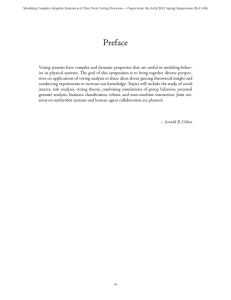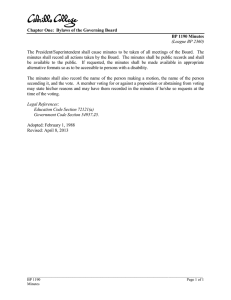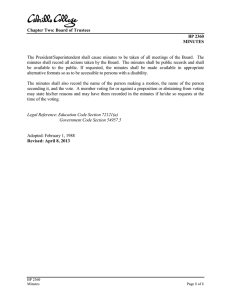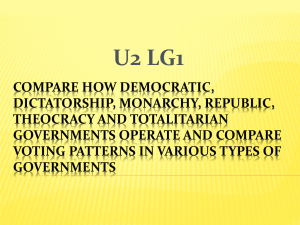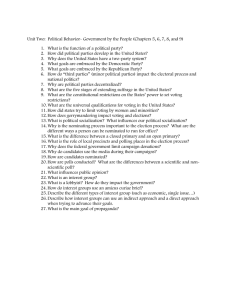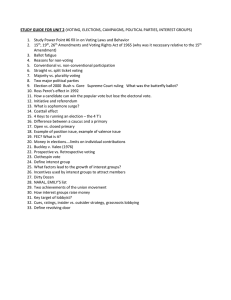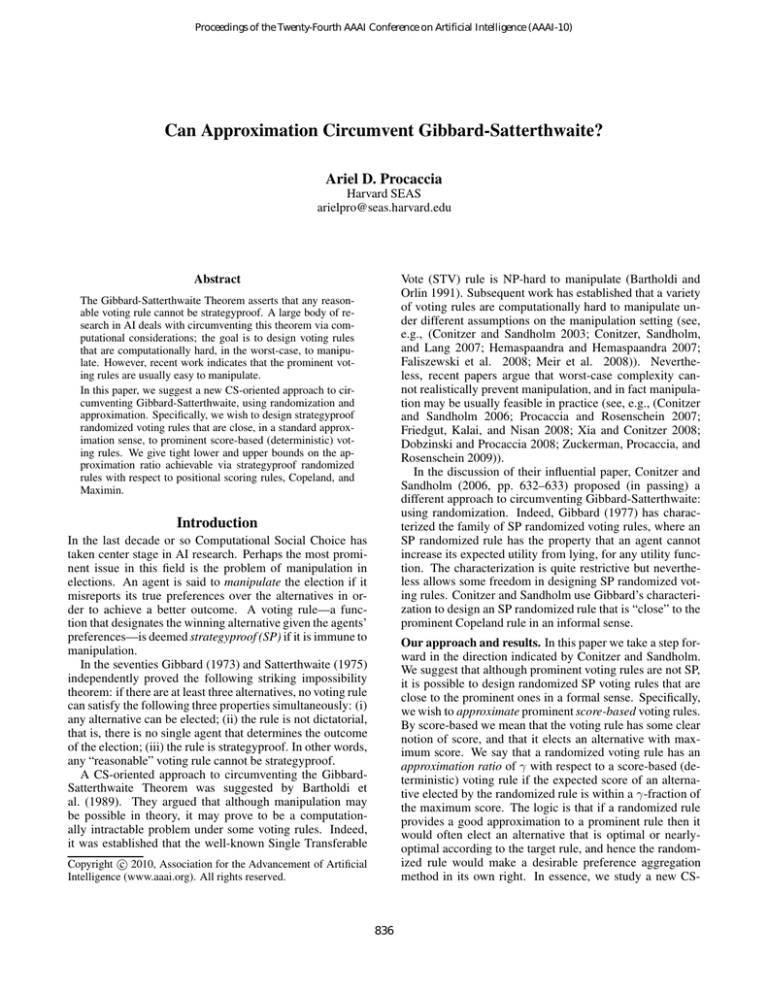
Proceedings of the Twenty-Fourth AAAI Conference on Artificial Intelligence (AAAI-10)
Can Approximation Circumvent Gibbard-Satterthwaite?
Ariel D. Procaccia
Harvard SEAS
arielpro@seas.harvard.edu
Abstract
Vote (STV) rule is NP-hard to manipulate (Bartholdi and
Orlin 1991). Subsequent work has established that a variety
of voting rules are computationally hard to manipulate under different assumptions on the manipulation setting (see,
e.g., (Conitzer and Sandholm 2003; Conitzer, Sandholm,
and Lang 2007; Hemaspaandra and Hemaspaandra 2007;
Faliszewski et al. 2008; Meir et al. 2008)). Nevertheless, recent papers argue that worst-case complexity cannot realistically prevent manipulation, and in fact manipulation may be usually feasible in practice (see, e.g., (Conitzer
and Sandholm 2006; Procaccia and Rosenschein 2007;
Friedgut, Kalai, and Nisan 2008; Xia and Conitzer 2008;
Dobzinski and Procaccia 2008; Zuckerman, Procaccia, and
Rosenschein 2009)).
In the discussion of their influential paper, Conitzer and
Sandholm (2006, pp. 632–633) proposed (in passing) a
different approach to circumventing Gibbard-Satterthwaite:
using randomization. Indeed, Gibbard (1977) has characterized the family of SP randomized voting rules, where an
SP randomized rule has the property that an agent cannot
increase its expected utility from lying, for any utility function. The characterization is quite restrictive but nevertheless allows some freedom in designing SP randomized voting rules. Conitzer and Sandholm use Gibbard’s characterization to design an SP randomized rule that is “close” to the
prominent Copeland rule in an informal sense.
The Gibbard-Satterthwaite Theorem asserts that any reasonable voting rule cannot be strategyproof. A large body of research in AI deals with circumventing this theorem via computational considerations; the goal is to design voting rules
that are computationally hard, in the worst-case, to manipulate. However, recent work indicates that the prominent voting rules are usually easy to manipulate.
In this paper, we suggest a new CS-oriented approach to circumventing Gibbard-Satterthwaite, using randomization and
approximation. Specifically, we wish to design strategyproof
randomized voting rules that are close, in a standard approximation sense, to prominent score-based (deterministic) voting rules. We give tight lower and upper bounds on the approximation ratio achievable via strategyproof randomized
rules with respect to positional scoring rules, Copeland, and
Maximin.
Introduction
In the last decade or so Computational Social Choice has
taken center stage in AI research. Perhaps the most prominent issue in this field is the problem of manipulation in
elections. An agent is said to manipulate the election if it
misreports its true preferences over the alternatives in order to achieve a better outcome. A voting rule—a function that designates the winning alternative given the agents’
preferences—is deemed strategyproof (SP) if it is immune to
manipulation.
In the seventies Gibbard (1973) and Satterthwaite (1975)
independently proved the following striking impossibility
theorem: if there are at least three alternatives, no voting rule
can satisfy the following three properties simultaneously: (i)
any alternative can be elected; (ii) the rule is not dictatorial,
that is, there is no single agent that determines the outcome
of the election; (iii) the rule is strategyproof. In other words,
any “reasonable” voting rule cannot be strategyproof.
A CS-oriented approach to circumventing the GibbardSatterthwaite Theorem was suggested by Bartholdi et
al. (1989). They argued that although manipulation may
be possible in theory, it may prove to be a computationally intractable problem under some voting rules. Indeed,
it was established that the well-known Single Transferable
Our approach and results. In this paper we take a step forward in the direction indicated by Conitzer and Sandholm.
We suggest that although prominent voting rules are not SP,
it is possible to design randomized SP voting rules that are
close to the prominent ones in a formal sense. Specifically,
we wish to approximate prominent score-based voting rules.
By score-based we mean that the voting rule has some clear
notion of score, and that it elects an alternative with maximum score. We say that a randomized voting rule has an
approximation ratio of γ with respect to a score-based (deterministic) voting rule if the expected score of an alternative elected by the randomized rule is within a γ-fraction of
the maximum score. The logic is that if a randomized rule
provides a good approximation to a prominent rule then it
would often elect an alternative that is optimal or nearlyoptimal according to the target rule, and hence the randomized rule would make a desirable preference aggregation
method in its own right. In essence, we study a new CS-
c 2010, Association for the Advancement of Artificial
Copyright Intelligence (www.aaai.org). All rights reserved.
836
a ranking that is inconsistent with ui is greater than the expected utility from reporting a ranking that is consistent with
ui . A randomized voting rule is strategyproof (SP) if it cannot be manipulated for any i ∈ N and ui . This definition is
quite strong as it requires nonmanipulability with respect to
every utility function.
We next present a necessary condition for SP randomized
rules. We say that a voting rule f is unilateral if it only
depends on the vote of a single agent, that is, if there exists
i ∈ N such that for every ≻, ≻′ ∈ Ln where ≻i =≻′i it holds
that f (≻) = f (≻′ ). We say that a voting rule f is duple if its
range is of size at most two, i.e., there exist x, y ∈ A such
that f (≻) ∈ {x, y} for all ≻∈ Ln . A randomized voting
rule f is a probability mixture over voting rules f1 , . . . , fk
if there exist α1 , . . . , αk , with αj ≥ 0 for all j = 1, . . . , k
Pk
and j=1 αj = 1, such that given ≻∈ Ln it holds that
f (≻) = fj (≻) with probability αj .
oriented approach to preventing manipulation by employing randomization and approximation, two concepts that are
prevalent in algorithmics.
We first consider the family of positional scoring rules.
We show that any positional scoring rule can be approximated
√ by an SP randomized voting rule to a factor of
Ω(1/ m), where m is the number of alternatives. This
result holds in particular for the Plurality rule, where each
agent votes for a single alternative. We demonstrate that no
SP randomized rule can do asymptotically better. We further
show that Borda—where each agent awards m − k points to
the alternative it ranks kth—can be approximated by an SP
randomized rule to a factor of 1/2 + Ω(1/m), and that this
bound is essentially tight.
We next investigate Copeland’s rule, where the score of
an alternative is the number of other alternatives it beats in
pairwise elections. We show that Copeland can be approximated by an SP randomized rule within 1/2 + Ω(1/m), and
provide a matching upper bound. Finally, we show that the
Maximin rule cannot be approximated to any nontrivial factor by SP randomized rules.
We would like to stress that we do not use approximation
to circumvent computational complexity, as in work on algorithmically approximating hard-to-compute voting rules,
e.g., Dodgson’s rule (Caragiannis et al. 2009). Rather, approximation is employed to achieve strategyproofness. Indeed, by the Gibbard-Satterthwaite Theorem the prominent
voting rules are not SP, but by randomly deviating from the
original rules we can achieve strategyproofness. The question is how close we can be while maintaining strategyproofness. In this sense this paper is related to the recent work on
approximate mechanism design without money (Procaccia
and Tennenholtz 2009).
Theorem 1 (Gibbard (1977)). An SP randomized voting
rule is a probability mixture over rules each of which is either unilateral or duple.
Our goal in this paper is to construct SP randomized rules
that approximate prominent score-based voting rules. We
say that f : Ln → A is a score-based voting rule with score
function sc : A × Ln → N if for every ≻∈ Ln , f (≻) is
an alternative x ∈ A that maximizes the score sc(x, ≻). A
randomized rule f is said to yield an approximation ratio
of γ with respect to a score-based voting rule f ′ with score
function sc if the expected score of the elected alternative is
optimal up to a factor of γ, that is, for all ≻∈ Ln ,
E[sc(f (≻), ≻)] ≥ γ · max sc(x, ≻) ,
x∈A
where the expectation is taken over the randomization of f .
Preliminaries
Positional Scoring Rules
Let N = {1, . . . , n} be a set of agents, and let A be a set of
alternatives, |A| = m. The preferences of agent i ∈ N are
given by a linear order ≻i ∈ L over the alternatives, where
L = L(A) is the set of all linear orders over A. A collection of the agents’ preferences ≻= h≻1 , . . . , ≻n i ∈ Ln
is called a preference profile. Given ≻i , we denote by
≻i (x) ∈ {1, . . . , m} the position of x ∈ A in ≻i ; to avoid
confusion note that position 1 is the top position and position
m is the bottom position.
A voting rule is a function f : Ln → A that designates
a winning alternative given a preference profile. A randomized voting rule (also known as a decision scheme (Gibbard
1977)) is a function f : Ln → ∆(A) that returns a probability distribution over A. In other words, a randomized
voting rule is allowed to use randomization when selecting
an alternative.
We informally define manipulation of randomized voting
rules, following the definition of Gibbard (1977); a formal
definition is not required for the purposes of this paper. Associate with agent i ∈ N a utility function ui : A → R+ .
We say that ≻i is consistent with ui if x ≻i y implies
ui (x) ≥ ui (y). Agent i manipulates a randomized voting
rule f if there exist preferences for the other agents such
that the expected utility (with respect to ui ) from reporting
Positional scoring rules are a central family of score-based
voting rules, which have received significant attention in AI
in recent years (see, e.g., (Hemaspaandra and Hemaspaandra 2007; Procaccia and Rosenschein 2007) for papers that
focus exclusively on positional scoring rules). A positional
scoring rule is defined by a vector of nonnegative real numbers α
~ = hα1 , . . . , αm i. The score of an alternative given a
preference profile ≻∈ Ln is defined as
X
sc(x, ≻) =
α≻i (x) .
i∈N
Informally, the alternative is awarded αj points by every
agent that ranks it in the jth place. There are three prominent
scoring rules:
1. Plurality: α
~ = h1, 0, . . . , 0i.
2. Borda: α
~ = hm − 1, m − 2, . . . , 0i.
3. Veto: α
~ = h1, . . . , 1, 0i.
In order to gain some intuition, let us consider the randomized voting rule that simply selects an alternative uniformly at random. This rule is clearly SP. However, in general it cannot guarantee a nontrivial approximation ratio with
837
the first transition follows from the fact that
where
P
x∈A\{a} sc(x, ≻) = SUM − OPT. The approximation
ratio achieved by the algorithm is then at least
respect to positional scoring rules. Indeed, consider the Plurality rule and a preference profile where all the agents rank
an alternative a ∈ A first. It holds that the optimum is n,
whereas the expected Plurality score of a random alternative
is n/m. Hence, choosing a random alternative provides an
approximation ratio of at most 1/m.
Let us now consider a slightly more sophisticated method;
the following generic randomized voting rule depends on the
parameters of the positional scoring rule.
Rule 1. Select an agent i ∈ N uniformly at random.
Elect the winner according to the following probability
distribution:
P the probability of alternative x ∈ A is
α≻i (x) / m
j=1 αj .
Note that this rule is a probability mixture over unilateral
rules. Indeed, for every i ∈ N , j ∈ {1, . . . , m}, let fik be
the unilateral rule that, given ≻∈ Ln , selects the alternative
ranked in the kth positionPof ≻i . Then Rule 1 uses each fik
m
with probability αk /(n · j=1 αj ).
Next we observe that Rule 1 selects an alternative x ∈ A
with probability
X1
α≻ (x)
sc(x, ≻)
· Pmi
= P
.
(1)
n
j=1 αj
y∈A sc(y, ≻)
OPT2 + (SUM−OPT)
1
m−1
·
SUM
OPT
.
(2)
By differentiating with respect to OPT we conclude that
the expression
in Equation 2 is minimized when OPT =
√
SUM/ m. Substituting this expression back into Equation (2) gives the announced bound.
It is natural to ask whether the analysis in the proof of
Theorem 2 is tight. The answer depends on the parameters
of the scoring rule, but the answer is “yes” with respect to
some positional scoring rules. In particular, the theorem below establishes a powerful and general lower bound with respect to Plurality: no SP randomized voting rule can approximate Plurality to a factor asymptotically better than
√ the one
given in the statement of Theorem 2, namely ω(1/ m). The
theorem’s proof exploits Gibbard’s Theorem (Theorem 1),
and is given in the full version of the paper.
Theorem 3. No SP randomized
√ voting rule can approximate
Plurality to a factor of ω(1/ m).
i∈N
Put another way, the rule selects each alternative with probability proportional to its score.
Furthermore, notice that Rule 1 is SP. This is rather obvious, as if agent i reported ≻i and is selected by Rule 1 then
the expected utility with respect to ui is
X α≻i (x)
Pm
· ui (x) ,
j=1 αj
x∈A
Next we observe that the upper bound given in Theorem 3
does not hold with respect to some prominent positional
scoring rules, e.g., Borda. Returning to the proof of Theorem 2, note that for Borda it holds that OPT ≤ n(m − 1),
whereas SUM = nm(m − 1)/2. Therefore, OPT/SUM ≤
2/m, and the minimum of the expression in Equation (2) is
achieved when OPT = n(m − 1). Substituting these values
back into the expression, we obtain that Rule 1 yields an approximation ratio of 1/2 + Ω(1/m).1 We have obtained the
following corollary .
and this expression is clearly maximized when ≻i is consistent with ui . If, on the other hand, agent i is not selected by
the rule, then its vote is irrelevant to the outcome.
Finally, we provide a simple analysis that establishes the
approximation ratio yielded by Rule 1 with respect to positional scoring rules.
Theorem 2. Let f be a positional scoring rule with parameters α
~ . Then√the approximation ratio of Rule 1 with respect
to f is Ω(1/ m).
Corollary 4. Rule 1 gives a (1/2+Ω(1/m))-approximation
with respect to Borda.
It turns out that for the case of Borda even randomly
choosing an alternative (which is, as noted above, SP) in
fact gives a similar, but slightly worse, approximation ratio.
Indeed, the expected Borda score of a random alternative in
a profile ≻∈ Ln is
Proof. Let ≻∈ Ln be a preference profile. Assume without
loss of generality that a ∈ A maximizes the score according
to f , and let OPT = sc(a, ≻). We also denote
m
X
X
SUM =
sc(x, ≻) = n ·
αj .
x∈A
2
X 1
1 nm(m − 1)
n(m − 1)
· sc(x, ≻) =
·
=
.
m
m
2
2
x∈A
j=1
Since the optimum may be at most n(m − 1), this gives an
approximation ratio of 1/2.
Interestingly, it is possible to establish a matching lower
bound, that is, no SP randomized voting rule can give an
approximation ratio that is bounded away from 1/2 with respect to Borda. In other words, it is essentially impossible
to do better than randomly choose an alternative. The rather
straightforward technique used in the proof of Theorem 3
falls short here. Instead, we employ Yao’s Minimax principle (Yao 1977).
By Equation (1), alternative x is selected by Rule 1 with
probability sc(x, ≻)/SUM. Therefore, the expected score
of the winner according to the rule is
X sc(x, ≻)
OPT
· OPT +
· sc(x, ≻)
SUM
SUM
x∈A\{a}
X SUM − OPT 2
OPT2
1
≥
+
SUM
SUM
m−1
x∈A\{a}
(SUM − OPT)2
1
2
=
· OPT +
,
SUM
m−1
1
In general the approximation ratio is small for any positional
scoring rule where SUM is far greater than OPT.
838
xj ∈ A \ {x∗ } is certainly given by its score when it is
ranked once in each of the first m − 1 positions, that is,
Theorem 5. No SP randomized voting
rule can approximate
√
Borda to a factor of 1/2 + ω(1/ m).
Proof. We consider the zero-sum game where the strategies
of the row player are unilateral and duple rules, and the
strategies of the column player are preference profiles. The
payoff in the cell that corresponds to a profile ≻∈ Ln and
the rule f : Ln → A is the ratio between the Borda scores
sc(f (≻), ≻)/(maxx∈A sc(x, ≻)). The row player wishes to
maximize the payoff, whereas the column player wishes to
minimize the payoff. Note that, by Gibbard’s Theorem, the
set of mixed strategies of the row player contains all the SP
randomized voting rules. By the Minimax theorem, an upper bound on the approximation ratio of the best randomized SP voting rule is given by the expected approximation
ratio achieved by the best (deterministic) unilateral or duple
rule under some specific distribution over preference profiles. In the following we therefore construct a “bad” distribution over profiles.
√
Let n = m−1, and assume for ease of exposition that m
is an integer. We consider the distribution over preference
profiles induced by the following procedure.
sc(xj , ≻) ≤
2
b
a
d
c
k=1
(m − k) =
m(m − 1)
.
2
(4)
We first consider the case where f : Ln → A is a unilateral rule with respect to agent i. We claim that f chooses the
special alternative x∗ with small probability. Intuitively this
is true since, when only ≻i is considered, there is nothing
that distinguishes
x∗ from the other alternatives in positions
√
1, . . . , m.
Formally, let ≻∈ Ln be a preference profile generated
according to our procedure. As before, let x∗ ∈ A be the
special alternative with high Borda score with respect to ≻.
Then we claim that
1
,
(5)
Pr[f (≻) = x∗ | ≻i ] ≤ √
m
where the probability is taken over profiles generated by
the procedure, given that the ranking of agent i is ≻i .
Indeed, observe that since π1 is a random permutation
of {1, . . . , m − 1}, πi is also a random permutation of
{1, . . . , m − 1}. In other words, our procedure for generating profiles is equivalent to the following procedure: let
∗
≻i be a random permutation
√ of the alternatives; choose x
at random among the first m alternatives of ≻i , then complete the profile as before, that is, by choosing a position
for x∗ in every vote and shifting the rest of the alternatives
cyclically. Viewed this way, it is easy to see that the procedure has the following
√ property: for every two alternatives
y, y ′ ∈ A in the first m positions of ≻i we have that
Pr[y = x∗ | ≻i ] = Pr[y ′ = x∗ | ≻i ] .
(6)
√
Assume that f (≻) is an alternative in the first m positions
of ≻√
i . By Equation (6), for every alternative y ∈ A in the
first m positions of ≻i it holds that
1
Pr[y = x∗ | ≻i ] = √ ,
m
f (≻). In addition, if f (≻)
and in particular this is true for √
is not an alternative in the first m positions of ≻i then it
cannot be x∗ , that is,
1. Select an alternative x∗ ∈ A uniformly at random.
√
2. For each i ∈ N , select a position ki ∈ {1, . . . , m}
independently and uniformly at random. Agent i ranks
x∗ in position ki .
3. Choose a permutation π1 over {1, . . . , m − 1} uniformly
at random. For every i = 1, . . . , n − 1, let πi+1 (j) =
πi (j + 1), where the addition is cyclic, i.e., (m − 1) + 1 =
1.
4. Denote A \ {x∗ } = {x1 , . . . , xm−1 }. Intuitively, the
agents rank the alternatives in A \ {x∗ } cyclically in
the positions 1, . . . , ki − 1, ki + 1, . . . , m. Formally, for
j = 1, . . . , ki − 1, agent i ranks alternative xπi (j) in position j. For j = ki + 1, . . . , m, i ranks alternative xπi (j−1)
in position j. See Table 1 for an example.
1
c
b
a
d
m−1
X
3
d
b
c
a
Pr[f (≻) = x∗ | ≻i ] = 0 .
Equation (5) directly follows.
We can now conclude that for every ≻i ∈ L,
√
m−1 m(m−1)
√1 (m − 1)2 + √
·
sc(f (≻), ≻) 2
m
m
√
≻i ≤
E
∗
sc(x , ≻)
(m − 1)(m − m)
√
1
m
√
≤ +
2 m− m
1
1
= +O √
,
2
m
where the first inequality is obtained by combining Equations (3), (4), and (5). Since this result holds for every
≻i ∈ L we have that
sc(f (≻), ≻)
1
1
E
≤ +O √
.
sc(x∗ , ≻)
2
m
Table 1: An example of a profile generated by the procedure
in the proof of Theorem 5. We have that x∗ = b, which is
placed in positions k1 = 2, k2 = 1, k3 = 2 in the rankings of
the different agents. The other three alternatives are ranked
cyclically in the remaining positions.
Let us compute the Borda scores of the different alternatives in a preference profile ≻∈ Ln generated according to
∗
the above
√procedure. The alternative x is always ranked in
the first m positions, hence
√
sc(x∗ , ≻) ≥ (m − 1) · (m − m) .
(3)
On the other hand, clearly sc(x∗ , ≻) ≤ (m − 1)2 . Furthermore, an upper bound on the score of each alternative
839
We next consider the easier case where f : Ln → A is a
duple rule. Since x∗ is selected at random, the probability
that x∗ is in the range of f is at most 2/m, hence the expected ratio is even worse.√By Yao’s Minimax principle, we
conclude that 1/2 + O(1/ m) is an upper bound on the approximation ratio that can be achieved via an SP randomized
voting rule
We have the following general result.
Theorem 6. Rule 2 gives a (1/2 + Ω(1/m))-approximation
with respect to Copelandα , for every α ≥ 1/2.
The proof of this theorem and the two subsequent proofs
are relegated to the full version of the paper. Once again,
it is possible to show that selecting an alternative uniformly
at random provides a slightly worse approximation ratio of
exactly 1/2 with respect to Copeland1/2 . We elaborate in the
discussion section.
To complete the picture, we next show that it it impossible
to to achieve an approximation ratio bounded away from 1/2
using an SP randomized voting rule.
We finally note that with respect to Veto, Rule 1 gives a
nearly perfect approximation ratio of 1 − O(1/m); this can
be seen by substituting OPT = n and SUM = n(m − 1)
into Equation (2). However, this may be a strange consequence of Veto’s representation as a positional scoring rule.
In fact, one is intuitively interested in minimizing the number of vetoes, that is, the number of agents that dislike a
given alternative above all others. However, this target is
difficult to approximate as the optimum may be zero. We
elaborate further in the discussion.
Theorem 7. Let α ∈ [0, 1]. No SP randomized voting rule
can approximate Copelandα to a factor of 1/2 + ω(1/m).
Maximin
The Maximin rule is also known as Simpson’s rule. The
score of an alternative under Maximin is defined as
Copeland and Lull
For a preference profile ≻∈ Ln and a pair of alternatives
x, y ∈ A let
P (x, y) = |{i ∈ N : x ≻i y}| .
Given α ∈ [0, 1], define the Copelandα score of x ∈ A as
sc(x, ≻) = |{y ∈ A \ {x} : P (x, y) > n/2}|
+ α · |{y ∈ A \ {x} : P (x, y) = n/2}| .
Put another way, an alternative receives a point for each
other alternative that it beats in a pairwise election, and
receives an α-fraction of a point for every tie. The importance of the tie-breaking issue was discussed in a number of recent papers (see, e.g., (Faliszewski et al. 2008;
2009)). Nowadays Copeland1/2 is attributed to A. H.
Copeland, whereas Copeland1 is credited to the 13th Century Majorcan philosopher Ramon Llull.
We consider the following randomized voting rule.
Rule 2. Choose a pair of alternatives uniformly at random.
If one is preferred to the other by a majority of agents then
it is the winner. Otherwise, flip a fair coin.
This rule is a probability mixture over duple rules. It is
furthermore straightforward that Rule 2 is SP: for a fixed
pair of alternatives that is selected by the rule, the manipulator is better off if the one with higher utility is elected, and
hence can only benefit by reporting its preferences truthfully
with respect to the pair. Since the argument holds for every
pair, we conclude that the manipulator’s best option is to
report truthfully. This was also observed in (Conitzer and
Sandholm 2006, Theorem 3).
Similarly to Rule 1 in the context of positional scoring
rules, Rule 2 elects an alternative with probability proportional to its Copeland1/2 score. Indeed, the probability of
electing alternative x ∈ A is
X
X
1
1
1
m +
m ·
2
2
2
y∈A: P (x,y)>n/2
=
sc(x, ≻) =
min P (x, y) ,
y∈A\{x}
where as before we define
P (x, y) = |{i ∈ N : x ≻i y}| .
Put another way, the score of x is the outcome of its worst
pairwise election.
It is easy to see that the natural SP randomized voting
rules, such as the ones employed above, fail in providing a
nontrivial approximation ratio with respect to Maximin. As
it turns out, this is the case with respect to any SP randomized voting rule.
Theorem 8. No SP randomized voting rule can approximate
Maximin to a factor of ω(1/m).
The intuition behind this result is that in some profiles the
Maximin score depends on a very specific pairwise competition. This makes the score hard to determine using a
random duple rule (in stark contrast to Copeland). Moreover, unilateral rules are in general unhelpful when it comes
to approximating voting rules that depend on pairwise elections. Hence, probability mixtures over unilateral and duple
rules cannot approximate Maximin.
Discussion
Table 2 summarizes our results; the table gives the lower
and upper bounds achievable by SP randomized rules with
respect to the voting rules in the left column. All our bounds
are tight (up to lower order terms).
Despite the tightness of the results, one might wonder
whether the lower bounds (that is, the possibility results)
are meaningful. In particular, in the context of Borda and
Copeland the “proportional rules”, Rules 1 and 2, give only
slightly better bounds than choosing an alternative at random. We wish to point out that the differences in the approximation ratio might be meaningful when the number of
alternatives is small. More importantly, we would like to design randomized voting rules that are “reasonable” in terms
y∈A: P (x,y)=n/2
sc(x, ≻)
sc(x, ≻)
= P
.
m
y∈A sc(y, ≻)
2
840
Rule
Plurality
Borda
Copelandα
Maximin
Lower √
bound
Ω(1/ m)
1/2 + Ω(1/m)
1/2 + Ω(1/m)*
0
Upper √
bound
O(1/ m)
√
1/2 + O(1/ m)
1/2 + O(1/m)
O(1/m)
of Jerusalem. Conitzer’s visit was supported by the United
States-Israel Binational Science Foundation grant 2006-216.
References
Bartholdi, J., and Orlin, J. 1991. Single Transferable Vote resists
strategic voting. Social Choice and Welfare 8:341–354.
Bartholdi, J.; Tovey, C. A.; and Trick, M. A. 1989. The computational difficulty of manipulating an election. Social Choice and
Welfare 6:227–241.
Caragiannis, I.; Covey, J. A.; Feldman, M.; Homan, C. M.; Kaklamanis, C.; Karanikolas, N.; Procaccia, A. D.; and Rosenschein,
J. S. 2009. On the approximability of Dodgson and Young elections. In Proc. of 20th SODA, 1058–1067.
Conitzer, V., and Sandholm, T. 2003. Universal voting protocol
tweaks to make manipulation hard. In Proc. of 18th IJCAI, 781–
788.
Conitzer, V., and Sandholm, T. 2006. Nonexistence of voting rules
that are usually hard to manipulate. In Proc. of 21st AAAI, 627–
634.
Conitzer, V.; Sandholm, T.; and Lang, J. 2007. When are elections with few candidates hard to manipulate? Journal of the ACM
54(3):1–33.
Dobzinski, S., and Procaccia, A. D. 2008. Frequent manipulability
of elections: The case of two voters. In Proc. of 4th WINE, 653–
664.
Faliszewski, P.; Hemaspaandra, E.; ; and Schnoor, H. 2008.
Copeland voting: Ties matter. In Proc. of 7th AAMAS, 983–990.
Faliszewski, P.; Hemaspaandra, E.; Hemaspaandra, L. A.; and
Rothe, J. 2009. Llull and Copeland voting computationally resist
bribery and constructive control. Journal of Artificial Intelligence
Research 35:275–341.
Friedgut, E.; Kalai, G.; and Nisan, N. 2008. Elections can be
manipulated often. In Proc. of 49th FOCS, 243–249.
Gibbard, A. 1973. Manipulation of voting schemes. Econometrica
41:587–602.
Gibbard, A. 1977. Manipulation of schemes that mix voting with
chance. Econometrica 45:665–681.
Hemaspaandra, E., and Hemaspaandra, L. A. 2007. Dichotomy
for voting systems. Journal of Computer and System Sciences
73(1):73–83.
Meir, R.; Procaccia, A. D.; Rosenschein, J. S.; and Zohar, A. 2008.
Complexity of strategic behavior in multi-winner elections. Journal of Artificial Intelligence Research 33:149–178.
Procaccia, A. D., and Rosenschein, J. S. 2007. Junta distributions
and the average-case complexity of manipulating elections. Journal of Artificial Intelligence Research 28:157–181.
Procaccia, A. D., and Tennenholtz, M. 2009. Approximate mechanism design without money. In Proc. of 10th EC, 177–186.
Satterthwaite, M. 1975. Strategy-proofness and Arrow’s conditions: Existence and correspondence theorems for voting procedures and social welfare functions. Journal of Economic Theory
10:187–217.
Xia, L., and Conitzer, V. 2008. Generalized Scoring Rules and
the frequency of coalitional manipulability. In Proc. of 9th EC,
109–118.
Yao, A. C. 1977. Probabilistic computations: Towards a unified
measure of complexity. In Proc. of 17th FOCS, 222–227.
Zuckerman, M.; Procaccia, A. D.; and Rosenschein, J. S. 2009.
Algorithms for the coalitional manipulation problem. Artificial Intelligence 173(2):392–412.
Table 2: A summary of the results. *Only α ∈ [1/2, 1].
of their social choice properties. In this sense, Rules 1 and 2
seem much better than the uniformly random election. For
example, a Condorcet loser (an alternative that loses to every other alternative in a pairwise election) has no chance of
being elected under Rule 2.
A minimal axiom that one might ask randomized voting rules to satisfy is positive response, informally defined
as follows: for every agent there is some profile where
the agent can increase an alternative’s probability of being
elected by pushing it upwards in its vote. This property is
satisfied by Rules 1 and 2, and is not satisfied when a uniformly random alternative is elected.
More generally, future research should specify the
desiderata that randomized voting rules must satisfy; it will
then be possible to ask whether there exist randomized voting rules that are strategyproof, satisfy the additional properties, and yield a good approximation ratio with respect to
prominent voting rules.
We have obtained results with respect to natural, prominent score-based voting rules. However, there are some
rules, which are formally score-based2, where it is unclear
which notion of score is the most natural one. One example
is Veto; we have seen that, as a scoring rule, Veto is easy to
approximate, but it remains open whether it is possible to approximate Veto when the winner is the alternative that minimizes the number of vetoes. Bucklin is potentially another
interesting example. Given a preference profile and an alternative x, let j be the minimum position such that a majority
of agents rank x in position j or above; define the Bucklin
score to be m − j. According to this definition choosing
a random alternative provides an approximation ratio of 1/4,
but using a surprising SP randomized voting rule one can obtain an approximation ratio of at least 13/48, that is, a ratio
that is bounded away from what can be obtained trivially.
We finally return to our original question, “Can approximation circumvent Gibbard-Satterthwaite?” Unfortunately
it is difficult to argue that the results in this paper provide a
positive answer. Nevertheless, our results do not preclude
good SP approximations with respect to notions of score
that were not considered above. In conclusion, we believe
that our approach offers new insights with respect to the manipulation problem, and may direct future work towards the
design of practical, applicable SP randomized rules.
Acknowledgments
Vincent Conitzer has made important contributions to this
paper, especially during a visit to the Hebrew University
2
In fact every voting rule is score-based with respect to some
ad hoc score function.
841

